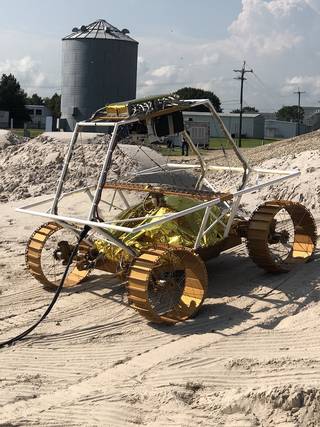
NASA seeking navigation cameras for new lunar rover
As part of NASA’s mission to return to the moon, the agency is seeking navigation cameras to be used on the new lunar rover, officials announced.
NASA is interested in the design, development, fabrication, and delivery of a low mass, low power, high performance Visible Imaging Subsytem (VIS) units comprised of Navigation Cameras (Navcams), Hazard Cameras (Hazcams), and Camera Controller hardware, with documentation and support, that meets the requirements for the VIPER mission, according to the announcement.
This effort is part of NASA’s Artemis lunar exploration program. NASA is preparing for a robust decade of modern science, research, and human exploration at the Moon, and the agency is asking American companies to think about how to get around on the lunar surface.
Earlier this year NASA issued two separate Requests for Information seeking industry approaches for development of robotic mobility systems and human-class lunar rovers. With these RFIs, NASA seeks to foster an emerging American market of lunar transportation capability by engaging the terrestrial vehicle and robotic communities.
First, the space agency asked for concepts on robotic mobility systems to transport instruments across the lunar surface, conduct critical scientific research across wide areas of terrain, including areas where humans may not explore.
“As we return to the Moon with Artemis, we’re seeking new and innovative approaches that allow us to operate robotically anywhere on the lunar surface and explore more of our nearest neighbor than ever before,” said Steve Clarke, deputy associate administrator for exploration, Science Mission Directorate at NASA Headquarters in Washington. “We are turning to industry to offer us exciting approaches to leverage existing systems here on Earth—including law enforcement, military, or recreational vehicles—that could be modified for use in space to enhance our mobility architecture.”
To expand the exploration footprints of the first woman and next man on the Moon, NASA also is seeking industry feedback on relevant state-of-the-art commercial technologies and acquisition strategies for a new lunar terrain vehicle or LTV. The LTV will be a human-rated, unpressurized (unenclosed) rover that will be used to help astronauts explore and conduct experiments somewhere humans have never been before: the lunar South Pole.
“The most we can expect crew to walk while wearing their spacesuits is about a half-mile,” said Marshall Smith, director of human lunar exploration programs in the Human Exploration and Operations Mission Directorate at NASA Headquarters. “If we can place a rover near a landing site before crew arrive, the potential for scientific return on those first missions will grow exponentially.”
Read more HERE.